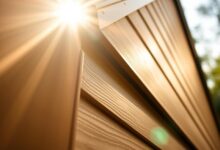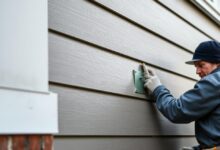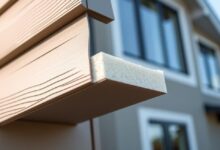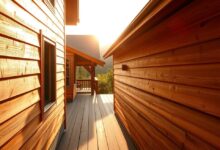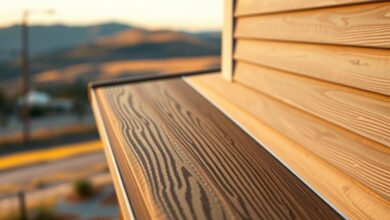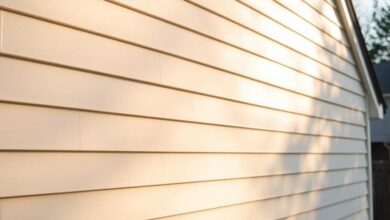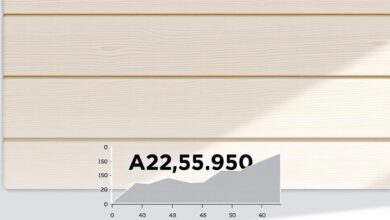Insulated Siding Repair Tips: Protect Your Home
Keeping your home’s exterior in top shape is vital for its longevity and value. A key part of home exterior maintenance is making sure your insulated siding is in good condition.
Damaged or worn-out siding can cause big problems. These include water getting in, wasting energy, and even harming the structure. Knowing how important insulated siding repair is can help homeowners protect their investment.
Using the right repair tips can help spot and fix issues early. This not only makes your home look better but also makes it last longer and use less energy.
Key Takeaways
- Regular maintenance is key to extending the life of your insulated siding.
- Identifying damage early can prevent costly repairs.
- Proper repair techniques are essential for maintaining energy efficiency.
- Well-maintained siding can significantly enhance your home’s curb appeal.
- Investing in quality repair can increase your home’s overall value.
Understanding Insulated Siding and Its Benefits
Insulated siding is key for homeowners wanting to safeguard their homes. It boosts a home’s look and offers many practical benefits.
What Makes Insulated Siding Different
Insulated siding stands out because it has an insulation layer. This layer sits between the siding and the house wall. It keeps the house cool in summer and warm in winter.
This makes homes with insulated siding more energy-efficient. They lose less heat in winter and gain less heat in summer.
Energy Efficiency and Home Protection Advantages
Insulated siding’s energy efficiency is a big plus. It means lower bills for heating and cooling. It also shields homes from rain, snow, and extreme weather, making them last longer.
Common Types of Insulated Siding Materials
Insulated siding comes in many materials, each with its own perks. Here are a few common ones:
| Material | Description | Benefits |
|---|---|---|
| Foam-Backed Vinyl Siding | A favorite for its toughness and easy upkeep. | Keeps energy costs down, doesn’t fade or crack easily. |
| Insulated Fiber Cement Siding | Looks like traditional siding but insulates well. | Long-lasting, fights pests and fire. |
| Expanded Polystyrene (EPS) Siding | Has a high insulation value. | High R-value, affordable. |
Each material has its own strengths. The right choice depends on what the homeowner wants. Knowing about these options helps homeowners pick the best for their home’s exterior.
Common Insulated Siding Damage Issues
Insulated siding has many benefits but can face several damage types. Knowing these issues helps keep your home’s exterior strong and lasting.
Weather-Related Damage
Weather can harm insulated siding. Extreme temperatures, heavy rain, and strong sunlight can cause it to expand and contract. This might lead to cracks and gaps. Proper installation and regular maintenance can help prevent these problems.
Impact and Physical Damage
Physical impacts, like falling branches or lawn equipment accidents, can also damage insulated siding. Regular inspections can spot damage early, allowing for quick fixes.
Age-Related Deterioration
With time, insulated siding can wear out. Materials may become brittle or change color. Regular checks and upkeep can tell when it’s time for a new one.
Moisture and Mold Problems
Moisture can cause mold and mildew on insulated siding. This harms its look and might weaken its structure. Keeping it dry and well-ventilated is essential to avoid these issues.
Essential Tools and Materials for Insulated Siding Repair
To fix insulated siding, you need the right tools and materials. Having the right tools makes the job easier and ensures a good repair.
Basic Tool Requirements
You’ll need a utility knife, pry bar, hammer, and tape measure for repairs. A utility knife is key for cutting siding to the right size. A pry bar helps remove damaged siding without harming the rest.
Specialized Materials for Insulated Siding
You’ll need materials that match your siding for the repair. This includes insulated siding panels, siding nails, and sealants. It’s important to pick the right siding nail for a strong fix. Sealants keep the siding tight and prevent future damage.
Where to Source Replacement Materials
You can find replacement materials at local hardware stores or home improvement centers. It’s wise to call first to check availability.
Make sure the materials match your siding’s color and texture for a perfect repair. Some makers offer matching services, which can be really helpful.
Insulated Siding Repair Tips: Step-by-Step Guide
Homeowners can fix insulated siding by following a detailed guide. This guide has several key steps. These steps help restore your home’s siding’s integrity and look.
Assessing the Damage Extent
The first step is to check how much damage there is. Look for cracks, dents, or where siding is loose. It’s key to find all damaged spots for a full repair.
Removing Damaged Sections
After finding the damage, remove the bad parts. Be careful not to harm the siding around it. Use a utility knife or a siding removal tool to gently pry away the damaged siding, making sure not to damage the insulation or wall.
Installing Replacement Panels
Next, put in new panels. Make sure they match the old siding in material, color, and style. Properly align the new panels with the existing siding, and fasten them with the right tools.
Sealing and Finishing Repairs
The last step is to seal and finish the repairs. Use a good sealant around the new panels to keep water out. Make sure the sealant works with the siding. Then, check the repair to make sure it looks good with the rest of the siding.
| Repair Step | Description | Tools/Materials Needed |
|---|---|---|
| Assessing Damage | Inspect siding for damage | Flashlight, ladder |
| Removing Damaged Sections | Carefully remove damaged siding | Utility knife, siding removal tool |
| Installing Replacement Panels | Install new siding panels | Replacement siding panels, fasteners |
| Sealing and Finishing | Seal edges, inspect repair | Sealant, caulk gun |
By following these steps, homeowners can fix their insulated siding. This improves their home’s protection and energy use.
DIY vs. Professional Repairs: When to Call the Experts
When you see insulated siding damage, you might wonder if you should fix it yourself or call a pro. The choice depends on how bad the damage is, how hard the fix is, and how good you are at DIY projects.
Projects Suitable for Homeowners
For small fixes like sealing gaps or replacing one panel, you can do it yourself. You’ll need basic tools and some DIY know-how.
Signs You Need Professional Help
But, if the damage is big or you see water getting in, you need a pro. Signs you need expert help include big structural damage, lots of mold or mildew, or if you’re not sure how to fix it.
Selecting a Qualified Contractor
When picking a contractor, look for their experience with insulated siding. Check their references, make sure they’re licensed and insured. A good contractor will give you a clear estimate and promise their work.
Questions to Ask Before Hiring
Before you hire someone, ask about their experience and how they plan to fix it. Make sure you know how long it will take and what you’ll pay. Understand what’s included in their service.
| Consideration | DIY Repair | Professional Repair |
|---|---|---|
| Cost | Lower upfront cost | Higher upfront cost |
| Expertise | Requires DIY skills | Professional expertise |
| Warranty | No warranty | Warranty provided |
Preventative Maintenance to Extend Siding Life
Keeping your insulated siding in good shape is key to its longevity and energy efficiency. Simple habits can stop small problems from getting big. This helps your siding last longer.
Seasonal Inspection Checklist
Seasonal checks are vital for your siding’s health. Look for damage like cracks, dents, or gaps. Make sure all panels are tight and there’s no water damage or mold.
- Inspect siding for physical damage
- Check for gaps or cracks
- Verify that all panels are securely fastened
Cleaning Methods That Won’t Damage Insulation
Regular cleaning keeps your siding looking good and working well. Use a soft brush or a gentle washer. Avoid harsh chemicals that could harm the insulation.
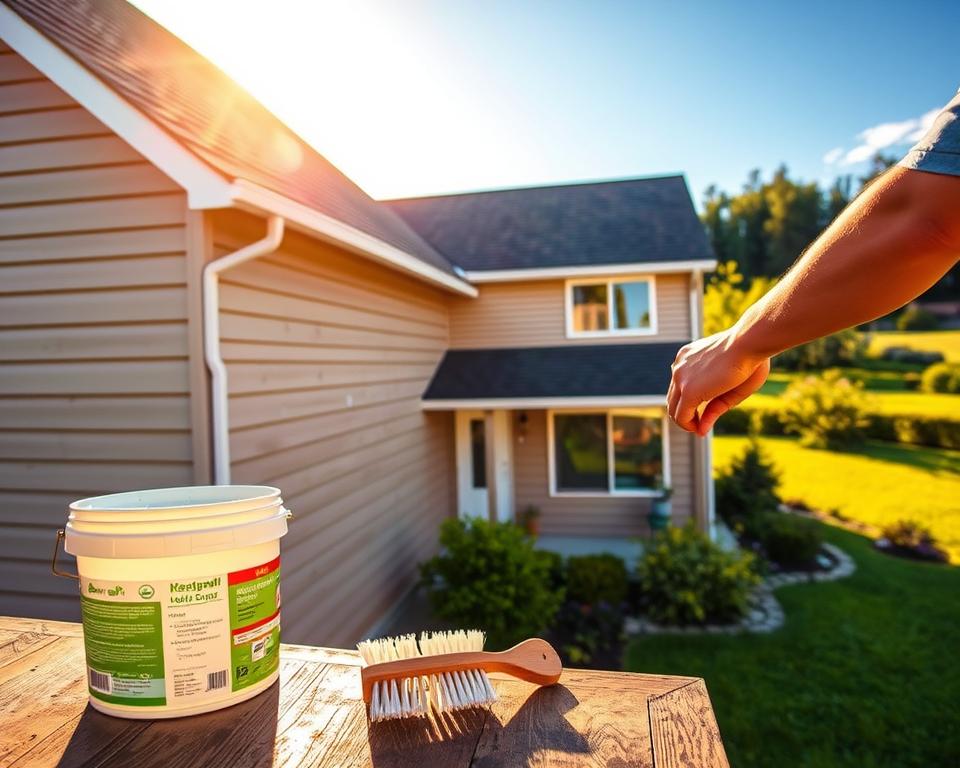
Simple Repairs That Prevent Major Issues
Fixing small problems quickly stops bigger ones from happening. Seal gaps and replace damaged panels as needed.
Landscaping Considerations to Protect Siding
How you landscape around your home matters for your siding. Keep plants and trees away from the siding. This prevents damage from moisture or physical contact.
By following these tips, you can make your insulated siding last longer. This keeps your home’s exterior safe and energy-efficient.
Cost Considerations for Insulated Siding Repairs
Knowing the cost of fixing insulated siding is key for homeowners. It helps keep their property’s value up. Insulated siding is a big investment, and fixing it can cost a lot.
Budgeting for Different Repair Scenarios
The cost to fix insulated siding changes based on the damage and materials needed. Small fixes, like sealing gaps or replacing a few panels, might cost a few hundred dollars. But bigger damage could mean spending thousands.
Homeowners should carefully check the damage to figure out how much work is needed. Getting quotes from different contractors helps compare prices and services.
Insurance Coverage Possibilities
Insurance might cover some insulated siding repairs, like damage from weather. Homeowners should check their policies to see what’s covered.
It’s important to document damage well with photos and detailed descriptions. This helps with insurance claims.
Long-Term Value of Proper Maintenance
Even though fixing insulated siding can be expensive upfront, regular care can help it last longer. This means you might not need to replace it as soon. Catching small problems early can save money by avoiding bigger repairs later.
Energy Savings After Proper Repairs
Insulated siding helps keep your home warm in winter and cool in summer. Fixing it right keeps this insulation working well. This can lead to lower energy bills. Keeping your siding in good shape makes your home more comfortable and saves on energy costs.
Conclusion: Protecting Your Investment in Insulated Siding
Keeping your home’s insulated siding in good shape is key to protecting your investment. It also helps keep your home energy-efficient. Knowing the benefits and common issues with insulated siding lets you fix problems early and avoid bigger ones later.
By following the repair tips from this article, you can fix your siding and make your home more energy-efficient. Regular checks and simple fixes can make your siding last longer.
By focusing on proper repair and upkeep, you can make your home more energy-efficient. This means lower bills and a longer-lasting siding. Taking care of your insulated siding now helps protect your home and investment for many years.
